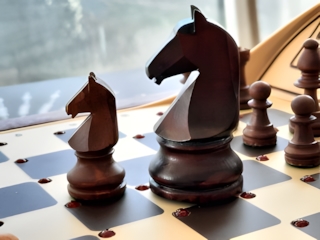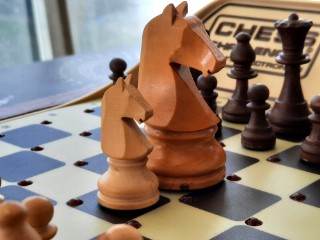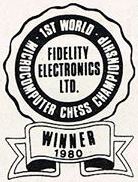My 'weak club player, class C
level' chess computers
Millennium ChessChampion 2.0
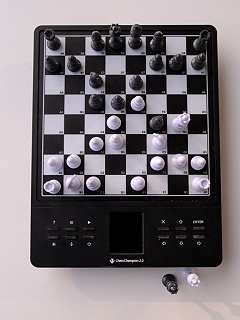
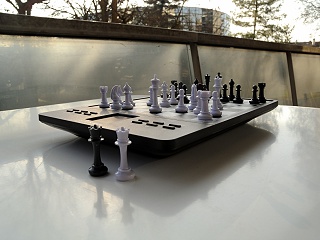 Year: 2024
Year: 2024
Programmer: Andrew Keatley
CPU: ARM Cortex M4 @48Mhz
ROM: 256Kb flash
Elo level: 1401 (1443
FIDE)
CMhz: 140
Rperf: 66%
Square size: 0.7"
Before boosting the market for strong devices (from 2015, with the ChessGenius), Millennium
offered many versions of entry-level chess computers aimed at the mass
market and (a priori) of little interest for a collection. Whilst the ChessChampion
2.0 keeps on targeting beginners or occasional players with regards to
its soft playing strength, and targeting the mass market thanks to its
low price (€69.90 catalog price, yet bought €39.99
promotional price at Aldi), it stands apart from its predecessors,
mainly thanks to a fast processor, a nice TFT color display
leveraging optimised graphics designed by Bryan
Whitby (check below pic), and an enhanced chess engine. According to
the programmer, enhancements are mainly about the behavior in the
endgame, the management of the King, and the appreciation of
passed pawns. The modern design, and the ability to be powered by an
adapter, were final arguments to persuade me. It is small, yet
proportions are definitely consistent; the display is easy to read; and
the squares are very reactive to any ligth pressure to enter the moves.
On another hand, the lack of room makes moving the tiny pieces touchy:
despite slightly magnetized, they easily slip on the chessboard. The
small keys provide a not very pleasant rubber feeling, but they
work fine. Menus and options are basic, nevertheless good enough for
simple, day to day use. The playing strength setting offers several
modes, of which a 'basic' one (scaling from one to ten), but the user
manual provides little information about. I myself use the 'move time'
mode, set to 15 seconds (values range from 5s to 4mn); I nevertheless
performed tests using those basic levels and, from my experience,
assessed the below range:

The level of strength looks to depend from several combined criteria,
of which the search depth resulting in more or less time used, and
obviously coupled with something else: most probably various accuracy
levels for the evaluation. Therefore, the level 6 searches less
in-depth than the level 5, but must use a smarter evaluation.
To conclude, the software features five playing styles; I leveraged the 'Spacious Mind reloaded' test to assess their relative strengths, and got the hereafter results:
The 'Normal' setting performs best; and more aggressive settings can be
used as alternatives that can make sense for variety. On another hand,
the passive settings greatly lower the playing level! Here is a graph:
Original picture: B. Whitby
Conchess Escorter + standard
module

 Year:
1982
Year:
1982
CPU:
6502 @2Mhz
ROM:
24Kb
Elo level:
1407 (1447
FIDE)
CMhz: 2
Rperf: 81%
Square size: 1.1"
I
long have been reluctant before entering a Conchess into my
collection: there are many evidences of failures, particularly due to
'Reed' switches issues. The chessboards are auto-sensory ones, with
three models offered: the Escorter here displayed, the Ambassador, and
the Monarch; all three of them are leveraging the same technology; but
offering increasing size and quality material. I finally pulled the
trigger for this fully working Escorter, offered for €150, the
reasonable dimensions of which fit me well. I like its silver and
copper shades! The Conchess brand has been registered by the Consumenta
Computer company in Munich, that previously retailed Fidelity
Electronics products in Germany; the manufacturing was entrusted to the
Waltham
Electronics company in Ireland; and the chess program is based on
Princhess, from the Swedish programmer Ulf Rathsman. Princhess had just
achieved an impressive second place after the
Fidelity X
(eXperimental) chess computer - at the WMCCC
(World MicroComputer Chess
Championship) in Travemünde, September 1981. All Three
Conchess boards are modular
type, they do not include any program or micro-processor; the claimed
objective being to enable both software and hardware upgrades thru
purchasing new moduls (two slots are available under the board). The
promise will hang fire, as Consumenta went
bankrupt as soon as 1983. Fortunately, the torch will be taken up in
Germany (by Loproc which had created the prototype
'computer und logikprozessor systeme' / EES 'Elektronic Entwicklung
Service'), and new moduls will be developed. This Escorter is equiped
with the standard modul initially sold, the playing level
is moderate (and fits me well!). It profits by some tactical
abilities, but sometimes lacks finishing skills to efficiently
score wins, despite domination. It particularly misses secure avoidance
of 3-rep. draws. On one of the squares, piece detection
revealed
itself weak: not working at first try after getting the device,
re-enabled using a stronger magnet (a Vonset piece!), I could play a
dozen of games before it failed again. I still had a spare MKA14103 Reed switch from the
previous repair of my Saitek Blitz, so I got my soldering iron out
again and I
opened the Escorter. No visible previous repair, so despite being in
line with the established reputation of the Conchess devices, one
failing switch after nearly 40 years in working order is sort of
acceptable! Next to this small repair, the Escorter is restored 100%
functional.
Mephisto II

 Year:
1981
Year:
1981
CPU:
1802 @3.5Mhz
ROM:
12Kb
Elo level:
1413 (1452
FIDE)
CMhz:
0.46
Rperf:
87%
I
initially entered the famous Mephisto 'briquette' program in my
collection with the Mephisto Mirage form factor (see below within this
page). Actually I was not that much keen on getting another chess
computer requiring keyboard input for moves coordinates... But the
announcement of a Mephisto 1X for €40, including mains adaptor
and
manual led me to move and buy this famous 'briquette'. Considering an
adapter is worth €15 if you need to buy one, the computer
itself
was offered at €25, it was not worth to do without... The
manual
is indeed a 1X one, but the removable cartridge is stamped 'II'
and tests reveal it is actually a Mephisto II. Thus a software
very close to the IIS one hosted in the Mirage - but the appreciably
lower speed and the form factor give this chess computer enough
difference to get its place within my collection, and I kept it. I
discovered a very pleasant to use keyboard, it is large enough and keys
are responsive with a soft but neat catch. The Nitsche
and Henne program is reknowned for offering a close to human-like play,
thanks to a highly selective analysis resulting in a very low speed
(analyzed nodes per second) compared to conventional programs which,
at that time, aimed mostly to pure speed.
Lexibook
Chesslight

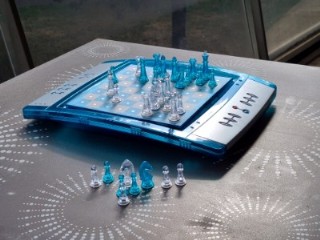 Year: 2001
Year: 2001
Programmer: Kaare
Danielsen
CPU:
SC551010P (?) @3,5Mhz (?)
ROM:
4Kb
Elo level:
1420 using
aggressive style (1457
FIDE)
CMhz: 2.45
Rperf: 81%
Square size: 0.91"
This
Chesslight looks like a toy, I even red a feedback from a
purchaser
who did not appreciate it, because the light effects were
reminiscent of a pinball to him! However, a long press on the
sound/color key disables part of these light effects, notably the
display of the moves that soberly resumes to the usual
lightning
of the source square then of the target square (otherwise, the full
path lightens square after square, this may entertain and help a child
or a very beginner, at the price of slowering the game). Anyway, this
electronic chess game does not concede much to tradition; apart of
course of its small 4K program based on Kaare Danielsen's Logichess
which really appears to power definitely each and every Lexibook, and
already equipped the Yeno 320XT introduced in the previous category
(and as well
equipped other Yeno, and other brands). The association of 64 LEDs (in
the center of each square) and translucent chessmen is much unusual,
despite not rid of some drawbacks; and more globally the design of this
electronic chess game, with the casing itself being translucent, is
really distinctive, colorful, bright and playful. These were the
reasons I was tempted to purchase one, and also in order to own a
device that would appeal to my grandchildren, for an introduction to
playing chess. I expected a cheap price, and the traditional set of
chessmen; as there is a stylized modern set I definitely dislike, at
first because of the Knight, like nothing on earth but maybe a stylised
alien or a plastic key (check the below picture). I found a real
bargain, €20 used, with the original box, the user manual, the
bag
to hold the pieces, and the VTech mains adapter included. As purchasing
separately an universal adapter would have costed me around
€15,
it was just like getting a €5 device! Let's now be more
specific
about the drawbacks of the central LEDs display system: in order to be
translucent enough (and cheap), the chessmen are made of thin hollow plastic,
so they are very light and little stable. As long as the chess computer
is quietly played on a table, no worries, but assuming
children
would play on the ground or with a bit of excitement, any small bump on
the device would shuffle the pieces. On another hand, I was pleasantly
surprised by the feel sensitivity of the squares, a light touch is
enough to register the moves; the side function keys are decent; thus
apart from the pieces and pawns, the quality of engineering of this
chess computer is really fine.
I spent many efforts to state
the
year the Chesslight reached the market; it is a timeless device still
offered today (I am writing in late 2022) on so many merchant websites
and chain stores, at a price new around €60 (without any mains
adapter). At first, you need to revert back to 1997 to place the
Lexibook buy-out of Yeno; Yeno used to name its devices with a three
digits number followed by two letters (301XL,
309XT,
320XT, 416XL, 532XL, 540XT...) whilst Lexibook is now using names (Chesslight,
Chessman Pro, Chessman Light,
Chessman Elite, Chessman Classic...). But in the early years, Lexibook
kept on using the Yeno codes; so the Yeno 325XI has been sold as Lexibook
325XI (1997), the 1994 Yeno 430XT came back to the market as Lexibook
430XT (before adopting the Chessman
Elite name, this device is still sold up to day, around €50!),
and the Lexibook
425XLights (or XLight, depending on whether you look at the box or at
the user's manual) that reached the market in 1999 is still keeping on
using that Yeno logic (but the 425XLights
has never been sold under the Yeno brand, as far as I know). And the Lexibook
425XLights, from a technical standpoint, is already the Chesslight; it
just still did not get the name. So, one can consider 1999 as the
origin birthdate of the Chesslight, maybe even the design dates back to
1997, assuming it was already part of Yeno's plans. But to be fair, the
Chesslight name must have appeared year 2001, as did the Chessman Pro
and Chessman Light names, thus I keep this date. A funny observation:
during a long time, the Lexibook user's manuals kept on being printed
using the Yeno models references; so I spotted a 2003 Lexibook
Chessmax with a 435XI manual; many used Chesslight classified ads
display a 425XLights
manual (mine did), and a Chesslight titled manual apparead only very
late. By the way, Lexibook is especially lazy or neglectful of updating
the manuals. As an evidence, the thinking times relating to the game
levels were definitely not updated. The microcontroller did evolve,
compared to the 68HC05 used by the old Yeno computers. The CPU Id
provided above is unsure: SC551010P
appears to be the label present on the Lexibook PCBs at the MCU place;
I could retrieve this Id on several chinese portals of electronic
components sellers, but I failed to access any details about. It is
supposedly a Motorola 68HC08 compatible microcontroller unit (successor
of the 68HC05). Leveraging several tests, I assessed my Chesslight is
75% faster than the Chessman Pro, which is known to be using the same
microcontroller paced with 2Mhz, therefore my clocking estimate of
3.5Mhz for my example. Despite this difference, the announced thinking
times are the same across both manuals (and probably already incorrect
for the Chessman Pro...). I used a stopwatch to evaluate the average
thinking times of my Chesslight, for the levels 6 to 11 (5s to 10mn
according to the manual); then I applied the proportional adjustment to
the announced times from the manual for the levels 12 to 15
(30mn to 24h, and
mate search). Of course the beginner's levels 1 to 5 keep on being
almost instant response; then the real averages are: 6=2 to 3s ;
7=3 to 4s ; 8=10 to 15s ; 9=20 to 30s ; 10=40 to 90s ;
11=2m30 to 3m ; and the proportionnaly adjusted manual times: 12=10 to 15m ; 13=45m to 1h ;
14=8 to 10h ; 15=Mate in : M1=1s ; M2=30s ; M3=30m ;
M4=10h ; M5=2weeks.
Being
close to three times faster than the Yeno 320XT (2.825 times for full
accuracy), the Chesslight plays one step stronger, thus is not a
duplicate in my collection, despite sharing the same program. In
addition, I decided to have it play using the aggressive style, to
still better get a different game compared to the Yeno (which I let
play using the normal style).
The ugly
Knight from the modern set!

The
Chesslight/425XLights looks modern, but it is a case in the small world
of chess computers: it is on the market since more than twenty years!
As
for it, the Chessman
Elite/430XT is over a quarter of a century of market presence
(1994-2022), and this might not be finished...

The
Chesslight makes me want to toy with the light!
Applied
Concept Sargon 2.5

 Year:
1979
Programmer: Dan
& Kathe Spracklen
Year:
1979
Programmer: Dan
& Kathe Spracklen
CPU:
6502 @2Mhz
ROM:
8Kb
Elo
level: 1434 (1467 FIDE)
CMhz:
2
Rperf:
82%
Square size: 1.01"
Mr
and Mrs Spracklen's programs left a mark on my early personal story
with computer chess, including Sargon I and II running on my
old
TRS-80, my correspondence game with Sargon II running on an Apple II,
then the Excellence. I mention as well their top Othello program
running on the Fidelity Reversi Challenger dated from 1981, on a
Sensory 9-like hardware, which will leave its own mark on several
international tournaments organized by the French
magazine l'Ordinateur Individuel. Sargon 2.5 is reknown for
being
the very first program made available on dedicated hardware and
offering acceptable chess skills, thus a must-have in my collection,
but hard to find. It is as well one of my highest second hand buying
cost,
€150 on German eBay. The program is exactly Sargon II with
added
ability to ponder over its opponent's move, thus justifying the 2.5
release name. However this is not a permanent brain feature: pondering
does not continue once the expected set level is met. Cumulating the
2Mhz speed of the 6502 and this thinking anticipation make the Sargon
2.5 able to use level 2 while respecting the 15 seconds per move pace,
whereas Sargon II either on overclocked TRS-80 (Z80
@2,66Mhz) or on Commodore 64 (6502 @1Mhz) cannot exceed level 1.
Permanent brain will later be provided in Spracklen's programs starting
from Sargon III and its derivatives. The Sargon 2.5 module is
connected here in a Great Game Machine (de luxe edition of the Modular
Game System, featuring a leather coated board). The module starts up
with a light blue LEDs displayed message 'Boris awaits your move' -
here we are on a familiar ground! The display keeps on displaying the
board one full row at a time, with symbols for each piece, a very
useful feature assuming one need to check or update the position. The
text speech concept inherited from the very first Boris continues with
Sargon 2.5; but the messages
are selected according to the more or
less advantageous position, thus
being more relevant. As Sargon requires the evaluation of the position,
the message if any is displayed at the end of the thinking time - thus
delaying the display of the chosen move. A key to speed-up or abort the
streaming of the message would have been useful. Talking about keys,
the keyboard despite being quite primitive is very sensitive and thus
pleasant to use.
Novag
Carnelian II
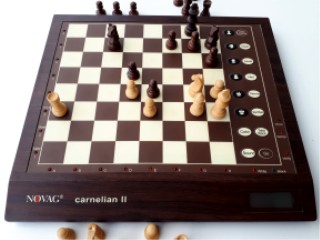
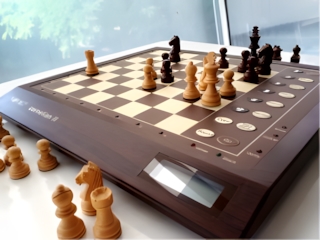 Year:
2005
Year:
2005
Programmer: Dave
Kittinger
CPU: KS57C2616 @8Mhz
ROM:
16Kb
Elo level:
1435 (1468
FIDE)
CMhz: 0.78
Rperf:
86%
Square size: 0.98"
Liking
vintage chess computers does not prevent from showing some interest
with more recent ones. Despite Dave Kittinger did not work any more for
Novag at this time, the program is a derivative of its predecessors,
with Novag's engineers work to provide many more playing levels (here
are 128 of them!). A significant part of the 16K ROM seems to be used
to manage these sophisticated levels and the opening book; and the tiny
RAM (768 bytes available, less than 1K!) led to removal of pondering.
As a result, the playing level is significantly below the one of a good
old 'true' 16K Kittinger program (you may check the Constellation in
stronger category page). The microcontroller used inside is not
announced by Novag, but the performance level provided by this
8Mhz singlechip is fully consistent with the performance of
former
devices from the same brand, using a 8Mhz 6301Y (external clocking,
four times divided for the computing of CPU instructions, resulting in
2Mhz actual CPU clocking). The probability is therefore very high for
the Carnelian II to host a similar microcontroller. Update: as a clone
of Opal+, Agate+ and more, and according to this low-midrange
list from Schachcomputer.info forum, the singlechip should be
a KS57C2616,
a 4 bits microcontroller, with only 768 RAM nibbles.
Being significantly less powerful than a 6502, the loss in strength
compared to old 16K devices is much explained. I bought this chess
computer still enclosed in its original packaging, at a reasonable
price
(€75), and despite the limited playing level I do not regret
this
buying: the push-sensitive board is very soft and responsive, very
pleasant to use, and the small wooden pieces are nice and consistently
sized, with a quite strong magnet providing a good holding on the
board.
Playing style is a bit passive, but assuming the program gets an
advantage, it is able to attack quite brilliantly. One of my preferred
opponents, as a conclusion.
Scisys
Kasparov Chess Companion III
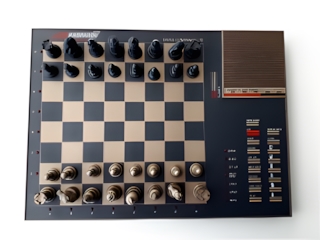
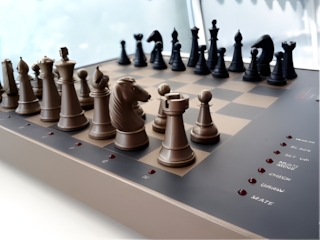 Year:
1986
Year:
1986
Programmer: Julio
Kaplan
CPU:
6301Y @8/4Mhz
ROM:
16Kb
Elo level:
1518 (1530
FIDE)
CMhz:
1.68
Rperf:
88%
Square size: 0.98"
The
2Mhz clocked 6301Y microcontroller (8Mhz divided by 4) is typical for
16K chess computers designed for the general public, it is available at
a lower cost than a 6502 but is less powerful. As far as pure computing
power is concerned, it is nevertheless roughly worth a 1.6Mhz 6502 one
can find, for instance, in an early released Sensory 9. I have
bought this one (€50) to include a Julio Kaplan (seconded by
Craig
Barnes) program into my collection, and I was not disappointed with it.
The chess skills of the former junior world champion provide a very
interesting playing style to this chess computer, less stereotyped than
others to my humble opinion. I read in the Wiki of schach-computer.info website
its permanent brain is supposed to ponder three most plausible
opponent's move, but the manual does not mention this clearly, and my
tests revealed one and only one pondered move, which is reasonable
assuming the very weak hardware (only 256 bytes of RAM!). This is a
limit of a singlechip microcontroller such as the 6301Y: it includes
CPU, RAM and ROM within a single component, a cost reduction industrial
concept, thus adding external RAM would kill the logic. One must manage
the situation as is, whereas a 6502 CPU will mandatorily benefit
from RAM components which can be scaled as needed (2Kb for
instance are available in a Sensory 9, that is to say 8 times more).
Vonset (aka
Femuey) L6

 Year:
2022
Year:
2022
Programmer: Vonset team
CPU: not communicated
ROM: not communicated
Elo level: 1529 (1539
FIDE)
CMhz: unknown
Rperf: unknown
KT: 1441
Square size: 1.1"
I ordered
this Vonset L6 smart board direct from China, using this portal, the
cost was $198 including shipment (€195 according to the change
rate applied then), on the ground of a discussion with its product
designer, who joined a forum about electronic chess. The explained
approach looked to me an interesting one: after several years
producing low-end games, re-using weak chess software, the factory
formed a strong hardware and software development team, upgraded the
chess engine (based on existing algorithms), and designed a new product
line, of which the L6 looks to be the first stone (a L6+ and a L6 Pro
appear to be planned). The company name is a bit of a puzzle, up to
there we were discussing about Vonset
Intelligent Electronic Technology
(Shenzhen) Co., Ltd; of which the first commercial use dates from late
2020, and registered in the US October, 2021. Who then did produce the
previous low-end designs? My guess is Year
Vantage Holdings Limited, owner of those brands: BrainGames,
Krypton and RYO; sharing some designs with the low-end Vonset or
Femuey.
Femuey
(Femuey Intelligent Electronic
Technology (Shenzhen) Co., Ltd.) is an alternate brand to Vonset, in
some cases, maybe some countries: I could not guess any rule for the
badging of one or the other brand; anyway the designs are the very
same, look and model number. To make it even more vague, my Vonset
user's manual also mentions 'Fermi smart
board' by 'Fermi
Technology'. Fermi looks to always be the brand badged on L6
in China, according to available snapshots; and a large
capital 'F' is displayed at power on of the board, by mean of the
squares LEDs.
These
diods are a key feature, and a very visible one, of this chess computer
design: each square can be light up with a color out of several (green,
blue, red, purple, white). Purple points out something requiring
special attention (e.g. King in check), white is the starting square of
a move (and green is the target square for a L6 move); and green/blue/red
are a color code for the legal squares a piece can reach, once the
player lifted it, planning to move it: green for a threat-free square,
red for a square where the piece can be captured, blue for a
particularly convenient square. It is therefore a light support for
beginners, showing the legal moves for the chosen piece, and advising
to calculate if the player plans to move it onto a red square.
The analysis resulting in the squares colors is only run at ground
surface, therefore a red square may be a correct target, for example if
the capture threat can be balanced by a re-capture. Any illegal move
tentative would result in the wrong square being lighten up as red. Of
course this coaching feature can be disabled using the options menu,
and the LEDs can be dimmed (two levels are available). In addition, the
moves are spoken, thanks to a synthetized voice (a woman's one, english
speaking, and there again it can be reduced, disabled, and sound level
can be set). The chessboard features an auto-response system, you only
need to pick-up a piece from the source square, and put it down on the
target square (without sliding the piece on the board, as this would
trigger intermediate detection). The detection uses powerful magnets
inserted at the bottom of each piece, and these thoroughly secure the
chess position: nice to enable easier use with children.

 Another key
visible element of the L6 is its electronic ink display (perfectly
legible whatever the viewing axis, under any light condition
or so). It can display the entire board position, the
evaluated position score, the list of moves; and it enables
easy access to the software menus.
Another key
visible element of the L6 is its electronic ink display (perfectly
legible whatever the viewing axis, under any light condition
or so). It can display the entire board position, the
evaluated position score, the list of moves; and it enables
easy access to the software menus.
The L6 offers useful features,
such as a game clock (without effect on the computer thinking time),
take back moves (illimited in training mode), auto power off if not
used for a while. Adjourning a game is easy, resuming it is instantly
done if the pieces remained on the board, otherwise the display enables
placing them back to the expected position (pieces can be stored in the
device drawer). A puzzle mode is also offered, with 1000 positions to
train with.
The
computer playing level is set using twenty values, providing instant
response (or so) up to level 17. Starting with level 18,
a LEDs animation appears until the move is computed, which
requires 2 to 5 seconds as an order of magnitude. The average thinking
time is less than 10 secs per move at level 19, and less than 20 secs
using the last, strongest level 20. Beware these are averages,
including fast play in the endgame; whilst during middlegame with still
many pieces present, one can assume up to four or five times these
values. As to the first ten levels, they are useless except for kids
initiation, preventing them from any loss: the computer will carefully
avoid to win. Starting with level 11, it is still a much easy opponent,
nevertheless will mate you if you let it doing so. The interesting
levels are therefore those from 11 to 20, and the increase in strength
looks to be rather well scaled across them.
The playing style
is rather dynamic; it can launch attacks even without complete
calculation; a likely indication for a selective approach in the
search.
Sometimes the attack brilliantly achieves a gain, sometimes it fails;
and it can commit blunders even up to levels 19 and 20, resulting in a
rather human style, pleasant for an intermediate level player (which I
am!). Reactive and attractive, user-friendly, it can especially fit
learning and training for children, in addition to being able to please
grown-ups.

Mephisto
Mirage

 Year:
1984
Year:
1984
Programmer: Thomas
Nitsche, Elmar Henne
CPU: 1806 @8Mhz
ROM: 16Kb
Elo level: 1533 (1542 FIDE)
CMhz: 1.06
Rperf: 91%
KT: 1339
Square size: 1.18"
The
Mirage module hosts the Mephisto II'S' program, once again accelerated
from 6.1 to 8Mhz. I initially bought this module with its dedicated
push-sensitive board (€75), but a row of squares started
failing
shortly after I got the board. Not a serious issue, I bought bare at
reasonnable price (€45) on the German eBay the modular board
shown
here. Once the module inserted and the mains adapter plugged in, the
Mirage was restored ready to play. On the other hand I had some trouble
to find convenient magnetic pieces: the magnet is mandatory to trigger
the 'reed' switches hidden under the playing surface, a sufficient
magnetic power is required, but too much of it results in gathering or
repelling pieces, and may eventually trigger aside square's
switches. Magnetic sets pieces revealed either too small with regards
to the board size, either too powerful because of the larger magnets
inserted in large chessmen (King, Queen). I finally bought a set of
pieces from a modular board, once again on German eBay (€28);
they
are designed with the consistent size to be used on the board
and
to be stored in the drawers beside the module, and the magnet size is
constant whatever the piece. I enhanced the plastic pieces with felt to
soften the contact with the playing surface, without disrupting the
magnetic field. Playing comfort is at top level with the modular board,
fortunately as the small keyboard provided on the module is quite
unpleasant, the keys are small and provide a rubbery feeling.
Cumulating the attractive sensitive board, the human-like playing style
of the program, and the level I can still beat, this is one of
my
favorite chess computers. Well, to be fully honest, it is my favorite
one.

Mephisto
Maestro Travel
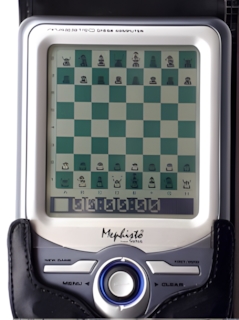
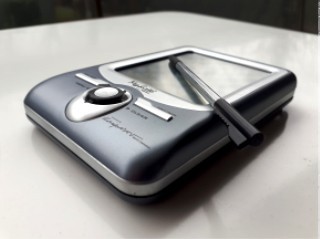 Year: 2004
Year: 2004
Programmer: Craig Barnes
CPU: H8 @7Mhz
ROM: 16Kb
Elo level: 1541 (1548 FIDE)
CMhz: 4,55
Rperf: 85%
Square size: 0.28"
After
the tiny Calculator Chess, this device is the second one being a pocket
chess computer, and being battery operated, within my collection. And
it is a Saitek, and a Craig Barnes as well... Actually I was looking
for a program from this author running on a more powerful hardware, and
I had an opportunity to buy this quite mint condition Maestro Travel,
close to my home, for a fair €35. It is a nice looking device,
designed like a PDA, despite being somewhat more bulky than most
personal data assistants. Like a Palm, it features a touch screen one
uses with a stylus. Chessmen design is clean and easy to recognize, the
lit-back display provides excellent playing comfort. This form factor
is fully relevant for playing while being mobile: you will not lose any
small piece from a pocket chessboard. The program shows some obvious
and frustrating bugs; as an example, level set to 15 secs per
move, it can announce mate in two (an actual situation)
and stalemate with its next move, or it can as well fail to checkmate
despite playing with Queen + King vs King! But don't run away, in most
won
situations, it actually wins... As comparing to a handheld is relevant,
it is slightly stronger than PocketChess running on a 4 to 5 times
faster Sony Clié (Dragonball @33Mhz).
Fidelity
Champion Sensory Chess Challenger
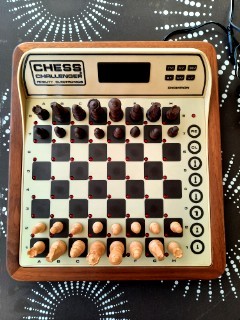
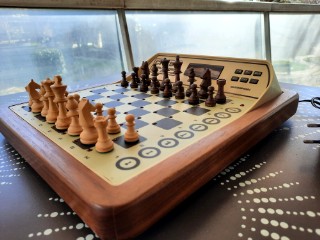 Year: 1981
Year: 1981
Programmer: Dan
& Kathe Spracklen
CPU:
6502 @1.95Mhz
ROM: 32Kb
Elo level: 1563 (1564 FIDE)
CMhz: 1.95
Rperf: 90%
Square size: 1"
Sargon
2.5, introduced previously in this page, was the first dedicated device
with a decent playing strength, but this chess computer is among the
first ones to be known for enhancements regarding the endgame. It is as
well the first Fidelity device to include a Spracklen program. So, it
is the forerunner of the whole lineage of strong Fidelity chess
computers, and it already has some genes (including thinking over
opponent's time) of Sargon III that will reach the market two years
later, late 1983 for the Apple II, before being adapted to other
microcomputers in 1984. Above all these considerations, it is the
winner of the very first World
MicroComputer
Chess Championship (WMCCC) in London, September 1980. It will make its
domination very clear by winning also the first Official North American
Microcomputer Chess Championship held in San Jose, California, in the
same few days. It won each and every nine games in nine rounds,
considering both competitions. It will hold the place of best performer
in Europe Echecs magazine's tests from November 1981 to April 1982,
being only evicted by its successor, the twice as fast Fidelity
Elite Champion Sensory
Chess Challenger (the name gets a bit long, doesn't it?). In addition
it is a beautiful device, with a heavy wooden frame and a nice finish.
It reuses the 1980' Voice
Sensory Chess Challenger casing, the only visible change being the "Champion"
label. The content is much different, as the "Voice" includes a much
weaker Ron Nelson's program, leveraging a Z80 clocked with 4Mhz,
providing less performance than the 2Mhz 6502. On another hand, both
chess computers are equipped with synthesized voice (mine speaking
French, with some funny results:
"castle"-"short" translates into "roque"-"petit", while the correct way
to say it in French is "petit roque"), and 64 classic grandmaster
games, to train oneself finding the best moves. One can as well select,
and use for training, any opening line you may choose. Should you
deduct the size of the ROM enabling these features, with the
voice as main one, the resulting program size can be estimated
between 16 to 20 Kb, for fair comparison sake. Another unusual feature
offered by the Champion is to enable tournament levels (number of moves
to be played during a given time, including a primary period and a
secondary one - e.g. 40 moves in 10 minutes, then 20 moves every 5
minutes). The setup process is somewhat complex; using the small six
keys keyboard on the sloping console. According to the function you
enter in, keys have different meanings: getting the user's manual is
thus essential. The small soft keys tend to loose conductivity with
time and usage (as do old television remote controls) and can so
require firm press, not to say they can end completely inoperative.
That was the actual situation with this device, otherwise mint
condition, complete with the original mains adapter, the user's manual,
and the Rexton case (Fidelity Electronic's vendor in France), bought
for €105 on French "le bon coin". Dismantling/reassembling is
a
bit tricky but practicable, and I glued some small circles punched from
a strong aluminium paper inside the keys; so the keyboard is enabled
again. The small wooden chessmen are really nice, I am pretty sure
Fidelity purchased them from France to the Chavet company (already
imported in the US, e.g. provider to the "Pacific
Game Company", and to "Cavalier"). I let you check, comparing with THE
reference piece, the Chavet knight:


 Year: 2024
Year: 2024


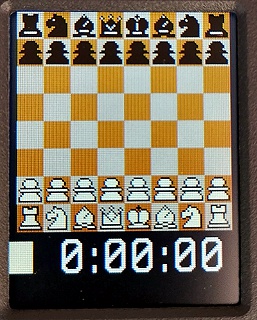

 Year: 2001
Year: 2001



 Year:
1979
Year:
1979
 Year:
2005
Year:
2005
 Year:
1986
Year:
1986
 Year:
2022
Year:
2022
 Another key
visible element of the L6 is its electronic ink display (perfectly
legible whatever the viewing axis, under any light condition
or so). It can display the entire board position, the
evaluated position score, the list of moves; and it enables
easy access to the software menus.
Another key
visible element of the L6 is its electronic ink display (perfectly
legible whatever the viewing axis, under any light condition
or so). It can display the entire board position, the
evaluated position score, the list of moves; and it enables
easy access to the software menus. 

 Year:
1984
Year:
1984

 Year: 2004
Year: 2004
 Year: 1981
Year: 1981